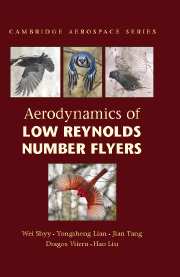Preface
Published online by Cambridge University Press: 05 July 2009
Summary
Low Reynolds number aerodynamics is important to a number of natural and manmade flyers. Birds, bats, and insects have been of interest to biologists for years, and active study in the aerospace engineering community has been increasing rapidly. Part of the reason is the advent of micro air vehicles (MAVs). With a maximal dimension of 15 cm and nominal flight speeds of around 10 m/s, MAVs are capable of performing missions such as environmental monitoring, survelliance, and assessment in hostile environments. In contrast to civilian transport and many military flight vehicles, these small flyers operate in the low Reynolds number regime of 105 or lower. It is well established that the aerodynamic characteristics, such as the lift-to-drag ratio of a flight vehicle, change considerably between the low and high Reynolds number regimes. In particular, flow separation and laminar–turbulent transition can result in substantial change in effective airfoil shape and reduce aerodynamic performance. Because these flyers are lightweight and operate at low speeds, they are sensitive to wind gusts. Furthermore, their wing structures are flexible and tend to deform during flight. Consequently, the aero/fluid and structural dynamics of these flyers are closely linked to each other, making the entire flight vehicle difficult to analyze.
The primary focus of this book is on the aerodynamics associated with fixed and flapping wings. Chapter 1 offers a general introduction to low Reynolds number flight vehicles, considering both biological flyers and MAVs, followed by a summary of the scaling laws, which relate the aerodynamics and flight characteristics to a flyer's size on the basis of simple geometric and dynamics analyses.
- Type
- Chapter
- Information
- Aerodynamics of Low Reynolds Number Flyers , pp. xvii - xviiiPublisher: Cambridge University PressPrint publication year: 2007



